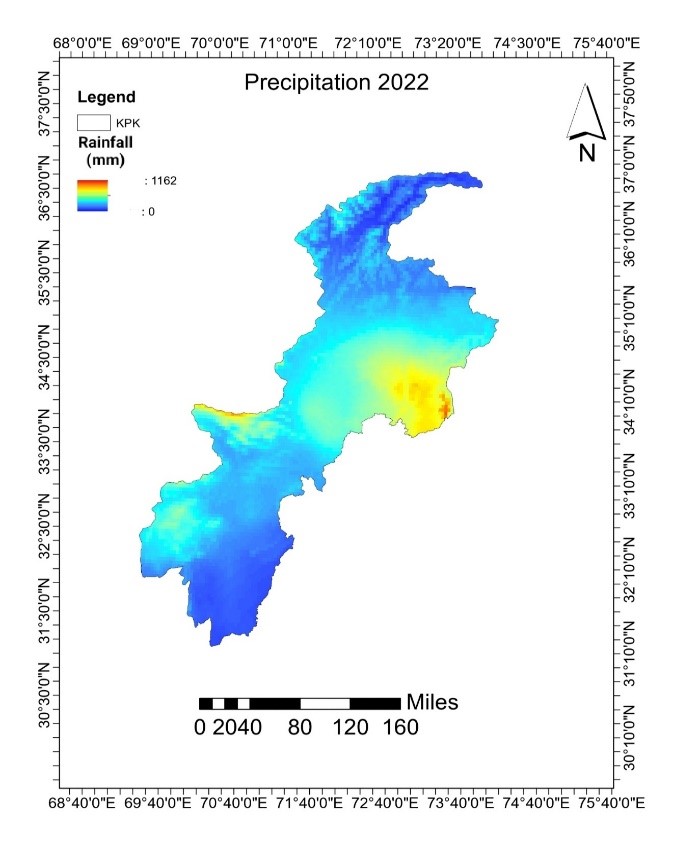Cause and Damages Assessment of 2022-Flood in Khyber Pakhtunkhwa, Pakistan
Keywords:
Floods, Causes, Damages, GIS, KP, Pakistan.Abstract
Floods are among the most devastating hazards, occurring globally and impacting many regions annually. Pakistan is frequently affected by floods, including the significant floods of 2022 in Khyber Pakhtunkhwa (KP). This study assesses the causes and damages of the 2022 floods in KP using data from NASA Worldview and USGS, complemented by Geographical Information System (GIS) analysis. The study considers the role of climate change and the topography of KP in making it prone to floods. It examines weather patterns, environmental factors, and local vulnerabilities that contributed to the floods, as well as the extent of damage to communities, infrastructure, and the environment. Flood and precipitation data were collected from two satellites and analyzed using ArcGIS. The study identified massive rainfall and increased temperatures as the primary causes of the flood. Significant damage was recorded in District Dera Ismail Khan, followed by Tank and Swat. The floods resulted in approximately 300 fatalities across various districts of KP and caused total economic losses estimated at 201,414 million Pakistani rupees. Public sector losses were estimated at 121,283 million PKR, with house damages amounting to 23,780 million PKR. The peak flooding occurred in August during high rainfall. Understanding the root causes and damages of the 2022 KP flood is crucial for developing effective prevention and mitigation plans, as well as for assessing the impact on communities, infrastructure, and the environment. This study provides critical insights and comprehensive data to inform disaster management and policy-making for future resilience. Its novelty lies in its exclusive focus on the 2022 KP floods, a topic not previously studied in detail. In conclusion, the research effectively analyzes the causes and assesses the damages of the 2022 Khyber Pakhtunkhwa flood, offering essential insights for improving flood management strategies.
References
H. Kreibich et al., “The challenge of unprecedented floods and droughts in risk management,” Nat. 2022 6087921, vol. 608, no. 7921, pp. 80–86, Aug. 2022, doi: 10.1038/s41586-022-04917-5.
B. Biswas, R. Remesan, M. K. Tiwari, and S. Ghosh, “Rapid Assessment of Flood Inundation Due to Tropical Cyclones in Part of Sundarbans in Google Earth Engine Environment,” pp. 77–95, 2024, doi: 10.1007/978-981-97-2879-4_6.
A. Tariq et al., “Flash Flood Susceptibility Assessment and Zonation by Integrating Analytic Hierarchy Process and Frequency Ratio Model with Diverse Spatial Data,” Water 2022, Vol. 14, Page 3069, vol. 14, no. 19, p. 3069, Sep. 2022, doi: 10.3390/W14193069.
“Potential impacts of climate change on hydrological extremes in the Incomati River Basin.” Accessed: Aug. 06, 2024. [Online]. Available: https://open.uct.ac.za/items/46c04e3d-5d7b-4b2b-b889-6b2f0f5f2f88
H.-U. Rahman, A. Khan, A.-U. Rahman, and R. Shaw, “Spatio-Temporal Dynamics of Land Use Land Cover and Its Impact on Flood-Prone Drainage Basin of River Swat, Eastern Hindukush,” Surf. Environ. Hum. Interact., pp. 29–40, 2024, doi: 10.1007/978-981-97-0112-4_3.
K. Alderman, L. R. Turner, and S. Tong, “Floods and human health: A systematic review,” Environ. Int., vol. 47, pp. 37–47, Oct. 2012, doi: 10.1016/J.ENVINT.2012.06.003.
I. Khan, H. Lei, A. A. Shah, I. Khan, and I. Muhammad, “Climate change impact assessment, flood management, and mitigation strategies in Pakistan for sustainable future,” Environ. Sci. Pollut. Res., vol. 28, no. 23, pp. 29720–29731, Jun. 2021, doi: 10.1007/S11356-021-12801-4/METRICS.
B. Merz et al., “Causes, impacts and patterns of disastrous river floods,” Nat. Rev. Earth Environ. 2021 29, vol. 2, no. 9, pp. 592–609, Aug. 2021, doi: 10.1038/s43017-021-00195-3.
S. M. H. Shah, Z. Mustaffa, F. Y. Teo, M. A. H. Imam, K. W. Yusof, and E. H. H. Al-Qadami, “A review of the flood hazard and risk management in the South Asian Region, particularly Pakistan,” Sci. African, vol. 10, p. e00651, Nov. 2020, doi: 10.1016/J.SCIAF.2020.E00651.
T. A. Khan, M. M. Alam, Z. Shahid, and M. M. Su’ud, “Investigation of flash floods on early basis: A factual comprehensive review,” IEEE Access, vol. 8, pp. 19364–19380, 2020, doi: 10.1109/ACCESS.2020.2967496.
S. Mahmood and A. ur Rahman, “Flash flood susceptibility modeling using geo-morphometric and hydrological approaches in Panjkora Basin, Eastern Hindu Kush, Pakistan,” Environ. Earth Sci., vol. 78, no. 1, pp. 1–16, Jan. 2019, doi: 10.1007/S12665-018-8041-Y/METRICS.
M. Farooq, M. Shafique, and M. S. Khattak, “Flood hazard assessment and mapping of River Swat using HEC-RAS 2D model and high-resolution 12-m TanDEM-X DEM (WorldDEM),” Nat. Hazards, vol. 97, no. 2, pp. 477–492, Jun. 2019, doi: 10.1007/S11069-019-03638-9/METRICS.
S. Mahmood, A. Sajjad, and A. ur Rahman, “Cause and damage analysis of 2010 flood disaster in district Muzaffar Garh, Pakistan,” Nat. Hazards, vol. 107, no. 2, pp. 1681–1692, 2021, doi: 10.1007/s11069-021-04652-6.
2022, “National Disaster Management Authority of Pakistan,” Flood Response Plan 2022, [Online]. Available: http://www.ndma.gov.pk/
S. Mahmood and K. Hamayon, “Geo-spatial assessment of community vulnerability to flood along the Ravi River, Ravi Town, Lahore, Pakistan,” Nat. Hazards 2021 1063, vol. 106, no. 3, pp. 2825–2844, Feb. 2021, doi: 10.1007/S11069-021-04568-1.
S. Mahmood, A. ul H. Khan, and S. Ullah, “Assessment of 2010 flash flood causes and associated damages in Dir Valley, Khyber Pakhtunkhwa Pakistan,” Int. J. Disaster Risk Reduct., vol. 16, pp. 215–223, Jun. 2016, doi: 10.1016/J.IJDRR.2016.02.009.
S. Fahad et al., “Evaluation of farmers’ attitude and perception toward production risk: Lessons from Khyber Pakhtunkhwa Province, Pakistan,” Hum. Ecol. Risk Assess. An Int. J., vol. 24, no. 6, pp. 1710–1722, 2018, doi: 10.1080/10807039.2018.1460799.
A. A. Shah, Z. Gong, N. A. Khan, I. Khan, M. Ali, and S. A. A. Naqvi, “Livelihood diversification in managing catastrophic risks: evidence from flood-disaster regions of Khyber Pakhtunkhwa Province of Pakistan,” Environ. Sci. Pollut. Res. 2021 2830, vol. 28, no. 30, pp. 40844–40857, Mar. 2021, doi: 10.1007/S11356-021-13598-Y.

Downloads
Published
How to Cite
Issue
Section
License
Copyright (c) 2024 50sea

This work is licensed under a Creative Commons Attribution 4.0 International License.




















